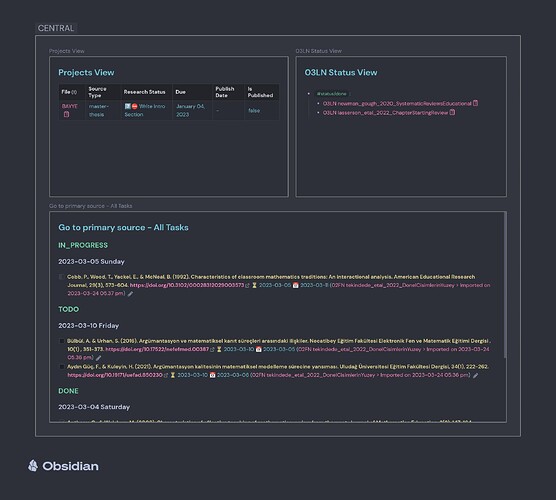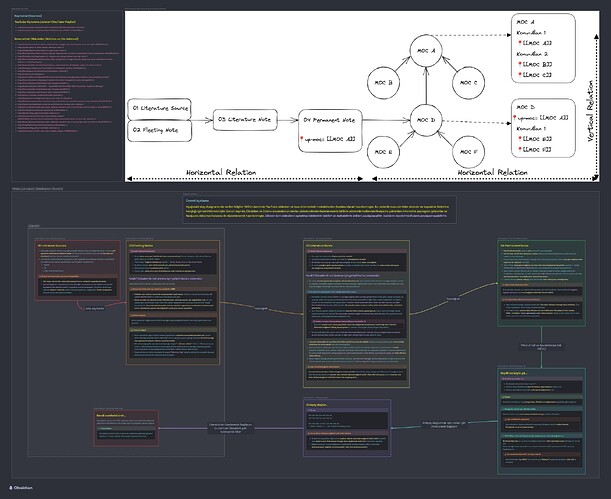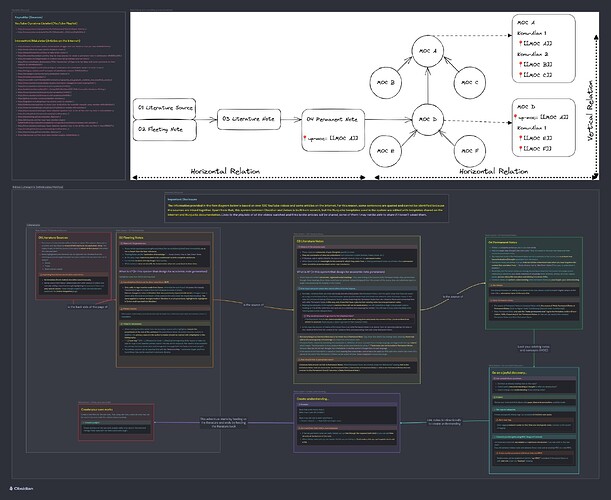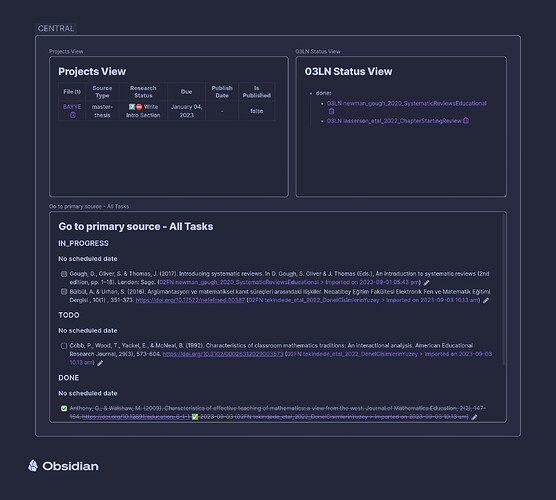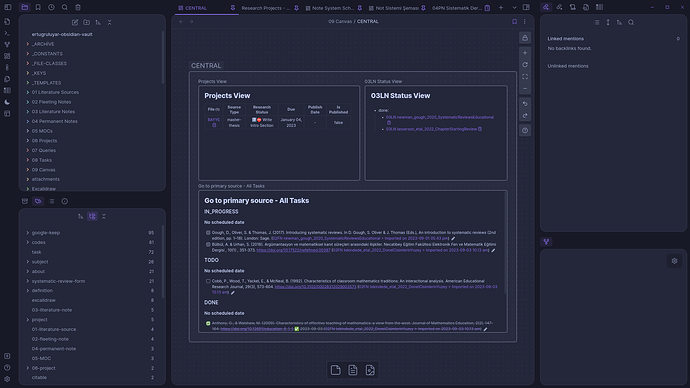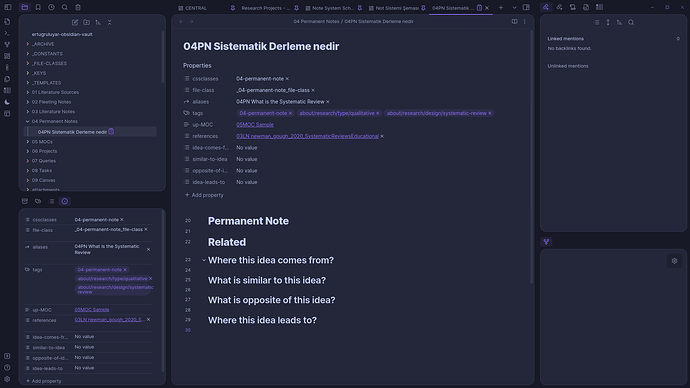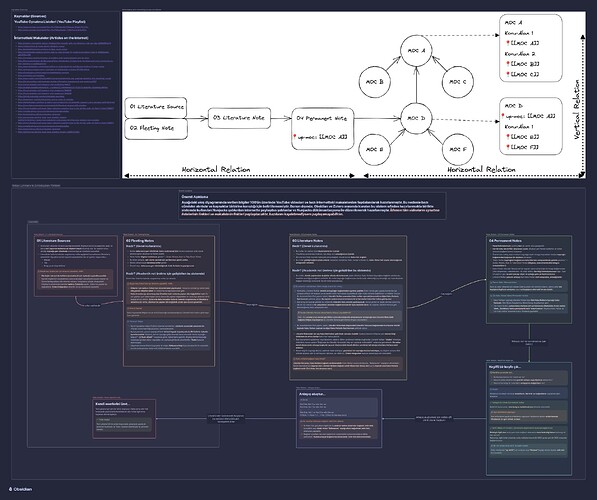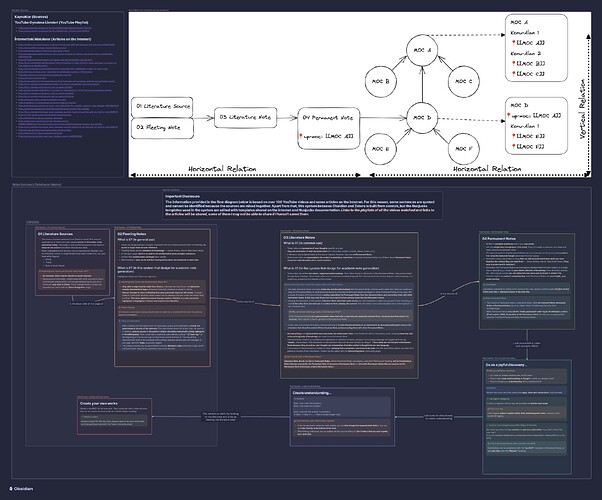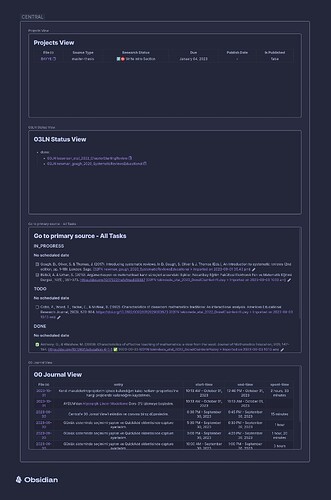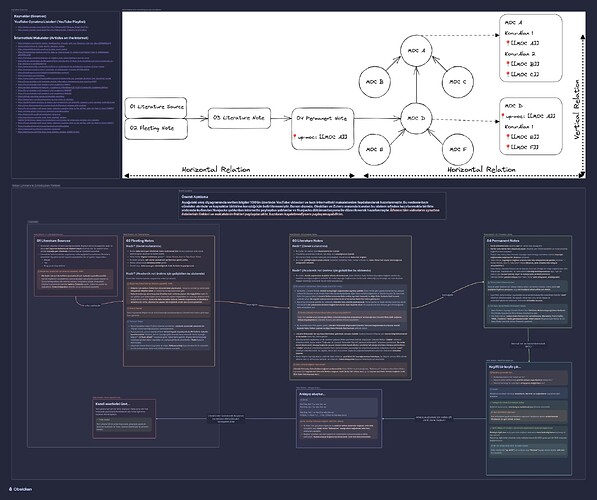Turkish Version
Bu resmi yüksek kalitede inceleyebilirsiniz: CENTRAL.png - Google Drive
Önemli Açıklama: Aşağıdaki akış diyagramında verilen bilgiler 100’ün üzerinde YouTube videoları ve bazı internetteki makalelerden faydalanılarak hazırlanmıştır. Bu nedenle bazı cümleler alıntıdır ve kaynaklar birbirine karıştığı için belirtilememiştir. Bunun dışında, Obsidian ve Zotero arasında kurulan bu sistem sıfırdan hazırlanmakla birlikte sistemde kullanılan Nunjucks şablonları internette paylaşılan şablonlar ve Nunjucks dökümantasyonu ile düzenlenerek hazırlanmıştır. İzlenen tüm videoların oynatma listelerinin linkleri ve makalelerin linkleri paylaşılacaktır, bazılarını kaydetmediysem paylaşamayabilirim.
Bu resmi yüksek kalitede inceleyebilirsiniz: Not Sistemi Şeması.png - Google Drive
01 Literature Sources
- Zotero’dan aktarılan notların kaynağı kaydedilir. Böylece Zotero’ya bağımlılık azalır ve ayrıca atıf yaparken kullanılacak bilgilerin kaydı tutulmuş olur. Bu sayede notun alındığı kaynağa geri dönülmek istenirse kaynak rahatlıkla bulunabilir.
- Literatürde fosforlu kalemle vurgulanmış notlar aşağıdaki kaynaklardan Obsidian’a aktarılabilir (İçe aktarma için hepsini kaydedebilen tek bir şablon oluşturuldu.):
- Makale
- Tez
- Kitap ya da kitap bölümü
[!caution] Birçok kez Zotero’dan içe aktarma yapılabilir.
- Elle hiçbir üst veri (ön bölüm) [metadata (front-matter)] kaydedilmemelidir.
- Kaynak bilgilerinin kaydedilmesi, Zotero’da diğer kaynaklarla kurulan ilişkiler ve Zotero’da kaynaklara elle eklenen notların (vurgulama yoluyla olmayanlar) Obsidian’a aktarılması işlemleri sadece Zotero’da yapılır. Zotero’da yapılan bu değişiklikler Zotero Integration eklentisi ile içe aktarılarak kaydedilir.
01 Literature Source Template.md (2.0 KB)
---
tags: [01-literature-source]
cssclass: 01-literature-source
file-class: [_01-literature-source_file-class]
citekey: {{citekey}}
source-type: {{itemType}}
title: "{{title}}"
{%- for type, creators in creators | groupby("creatorType") -%}{% if loop.first %}
{% endif %}{{type | replace("interviewee", "author") | replace("director", "author") | replace("presenter", "author") | replace("podcaster", "author") | replace("programmer", "author") | replace("cartographer", "author") | replace("inventor", "author") | replace("sponsor", "author") | replace("performer", "author") | replace("artist", "author")}}s: "{%- for creator in creators -%}{%- if creator.name %}{{creator.name}}{%- else %}{{creator.lastName}}, {{creator.firstName}}{%- endif %}{% if not loop.last %}; {% endif %}{% endfor %}"{% if not loop.last %}
{% endif %}{%- endfor %}
publicationTitle: "{{publicationTitle}}"
publisher: {% if publisher %}"{{publisher}}"{% endif %}
url: {{url}}
date: {{date | format("YYYY-MM-DD")}}
year: {{date | format("YYYY")}}
isbn: {% if ISBN %}{{ISBN}}{% endif %}
issn: {% if ISSN %}{{ISSN}}{% endif %}
language: {{language}}
edition: {{edition}}
volume: {{volume}}
issue: {{issue}}
---
# Navigation
fleeting-note:: [[02FN {{citekey}}]] ➡️
literature-note:: [[03LN {{citekey}}]] ➡️➡️
___
tags::
{%- if tags.length > 0 -%}
{% for t in tags %} #{{t.tag | lower | replace(" ", "-")}} {% endfor %}
{%- endif %}
___
> [!info]- Bibliography
> {{bibliography}}
>
>> [online]({{uri}}) [local]({{desktopURI}}) {%- for attachment in attachments | filterby("path", "endswith", ".pdf") %} [pdf](file://{{attachment.path | replace(" ", "%20")}}){% if loop.last %} {% endif %}{%- endfor %}
> [!abstract]- Abstract
> {{abstractNote}}
___
# Related with other literature sources
{% if relations.length > 0 %}
{%- for relation in relations %}- [[01LS {{relation.citekey}}]]
{% endfor %}
{%- endif %}
# Special comments about this literature source
{% if notes.length > 0 %}
{%- for note in notes | reverse %}comment:: {{note.note}}
{% endfor %}
{%- endif %}
02 Fleeting Notes
[!question] Nedir? (Genel kullanımda)
- Bunlar daha sonra geri dönülmek üzere unutmamak için hemen karalanan anlık olarak aklımıza gelen düşünce ve fikirler olabilir.
- “Anlık Notlar “bilginin hatırlatıcısı” gibidir.” ~ Sonke Ahrens, How to Take Smart Notes
- Bu erken süreçte, tam cümle yazmak için şartlanmaya gerek yoktur.
- Hızlıca alınan küçük karalama notlar gibidir.
- Önemli olan, daha sonra geri dönüldüğünde anlık notlarla ne yaptığımızdır.
Nedir? (Akademik not üretme için geliştirilen bu sistemde)
Zotero’dan fosforlu kalemle vurgulanmış notlar içe aktarılır.
[!caution] Birçok kez Zotero’dan içe aktarma yapılabilir. AMA!
- Etiketler için sadece Zotero’dan düzenlemeler yapılmalıdır. Yoksa bir sonraki içe aktarmada elle yazılan etiketler silinir ve Zotero’da ne kayıtlıysa onlar gelir.
- Daha önceden içe aktarılmış olan Obsidian’daki notlarda yapılan elle değişiklikler kalır. En son yapılan içeri aktarmadan sonra Zotero’da yapılan değişiklikler en sona (içe aktarma tarihi başlığı altına) eklenir. Zotero’da daha önceden fosforlu kalemle vurgulanmış ve Obsidian’a aktarılmış bir notta, Obsidian’da yapılan elle değişiklik içinde aynı durum geçerlidir.
[!attention] Birincil Kaynak
İkincil kaynaktaki bilgiler ancak birincil kaynağa ulaşılamadığında literatür notu haline getirmeye özen gösterilir.
[!todo] “Aktaran” Bilgisi
- İkincil kaynaktan bilgiyi fosforlu kalemle işaretlerken cümlenin sonundaki parantezi de (Yazarın atıfını belirttiği parantez.) dahil edilmelidir. Bunun yanında, yazarın yaptığı atıftaki bu birincil kaynağı kaynakçada da fosforlu kalemle işaretlenmelidir.
- Birincil kaynağa gidip okumak üzere kaynağın başına " - [ ] ‘task-etiketi’ " (Ctrl + L (Windows) ya da Cmd + L (Mac)) koyulurak görev listesi haline getirilir. Böylece birincil kaynağa ulaşılması gereken bütün kaynakları bir sayfada görülerek yönetilebilir. (Tasks topluluk eklentisiyle).
- Ulaşılmak istenen birincil kaynaklar ilk etapta “Reference Map” topluluk eklentisi ile aranabilir, burada bulanamazsa elektronik kütüphanelerde aranabilir.
02 Fleeting Note Template.md (1.5 KB)
---
tags: [02-fleeting-note]
cssclass: 02-fleeting-note
file-class: [_02-fleeting-note_file-class]
---
# Navigation
literature-note:: [[03LN {{citekey}}]] ➡️
literature-source:: [[01LS {{citekey}}]] ⬅
___
tags::
{%- if tags.length > 0 -%}
{% for t in tags %} #{{t.tag | lower | replace(" ", "-")}} {% endfor %}
{%- endif %}
___
> [!info]- Bibliography
> {{bibliography}}
>
>> [online]({{uri}}) [local]({{desktopURI}}) {%- for attachment in attachments | filterby("path", "endswith", ".pdf") %} [pdf](file://{{attachment.path | replace(" ", "%20")}}){% if loop.last %} {% endif %}{%- endfor %}
> [!abstract]- Abstract
> {{abstractNote}}
___
{% persist "annotations" -%}
{% set annotations = annotations | filterby("date", "dateafter", lastImportDate) %}
{% if annotations.length > 0 %}
# Imported on {{importDate | format("YYYY-MM-DD hh.mm a")}}
{%- for annotation in annotations -%}
{% if annotation.imageRelativePath %}
![[{{annotation.imageRelativePath}}]]
{% endif %}
{% if annotation.annotatedText -%}
**{{annotation.annotatedText}}**
{%- endif %}
{% if annotation.comment -%}
{{annotation.comment}}
{%- endif %}
tags::{% if annotation.tags %}{% for tag in annotation.tags %} #{{tag.tag}} {% endfor %}{%- endif %}
[Open in Zotero (p. {{annotation.pageLabel}})](zotero://open-pdf/library/items/{{annotation.attachment.itemKey}}?page={{annotation.pageLabel}}&annotation={{annotation.id}}) Imported on {{importDate | format("YYYY-MM-DD h:mm a")}}
___
{%- endfor %}
{% endif %}
{% endpersist %}
03 Literature Notes
[!question] Nedir? (Genel kullanımda)
- Bu notlar, bir metine özel düşüncelerinizin özetidir.
- Tüketilmiş içeriklerden (makale, tez, kitap vb.) anladığımızın özetidir.
- Bir literatür notu kaynak materyale sıkıca bağlıdır. Ancak bunlar kalıcı not değildir.
- Bu notlar geldiği bağlam içinde anlamlı olurlarken bunlardan kalıcı notlar üretirken bu kalıcı notlar tek başına okunduğunda anlaşılabilir olmalıdır.
Nedir? (Akademik not üretme için geliştirilen bu sistemde)
- Bu notlar, atomik yapılmadan, başlıklar altında düzenlenerek yazılır. Böylece Kalıcı Notların kaynağına bağlantı verirken bu başlıklar aracılığıyla bağlantı verilebilir. Bu notlar kaynağın bağlamından henüz izole edilmediği (sıyrılmadığı) için toplu biçimde bağlam bütünlüğü korunarak tek bir notta bulundurulur.
[!info] Bu sistemin orijinalinden farklı olduğu önemli bir nokta…
- Normalde, Literatür Notları atomik ve kaynağın bağlamından sıyrılmış şekilde (Kalıcı Notlar gibi) yapılıp bunlardan işe yarayan notların bir kopyası ya da kendisi Kalıcı Not olarak kaydedilerek diğer Kalıcı notlarla bağlantıları ve ilişkileri kurulur. Bu durumda Kalıcı Not yapma işlemi, Literatür Notları arasından Kalıcı notları ayırmak (seçmek) ve diğer Kalıcı Notlarla ilişki kurmak şeklinde işliyor. Bu sayede sadece mevcut notlarına bir artısı olanlar kalıcı not haline gelmiş olur.
- Aynı artıyı koruyacak şekilde, bu sistemde, Literatür Notu atomik yapılmayacak, bunun yerine bir başlık altında toplanmış tek bir not olacak ki bir çalışmadan alınanlar bağlam korunarak toplu biçimde olsun. Bu sayede Literatür Notuna geri dönüldüğünde daha anlaşılabilir olur.
[!question] Neden Literatür Notuna tekrar bakma ihtiyacı duyulabilir ki?
Kalıcı Not aradan uzun zaman geçtikten sonra okunduğunda anlaşılamıyor ve kaynağı olan Literatür Notundaki bağlama ihtiyaç duyuluyorsa bu Literatür Notuna geri dönme ihtiyacı duyulabilir.)
- Bu durumda Kalıcı Not yapma işlemi, Literatür Notundaki düşünceleri Literatür Notunun bağlamından kurtararak atomik biçimde Kalıcı Notları yazmak ve diğer Kalıcı Notlarla ilişki kurmak şeklinde işliyor.
- Literatür Notundaki her şey Kalıcı Not haline getirilmek zorunda değildir. Sadece mevcut notlarına yani mevcut bilgi birikimine bir artısı olanlar Kalıcı Not haline getirilir.
- Bazı kavramların açıklaması veya tanımının yabancı dilden çevrilmesi halinde oluşturulan Literatür Notları “citable” etiketiyle etiketlenir, bunun anlamı “Doğrudan bu Literatür Notundaki bilgi atıf yapılarak kullanılabilir.” anlamına gelmektedir. Bu notlar kendi düşüncemiz olmayıp başka bir yazarın düşüncesinin kendi dilimize çevrilmiş hali olduğu için Kalıcı Notlara dahil edilmez.
- Alınan bilginin kaynağı aktaran şeklinde ifade edildiyse, yani ikincil bir kaynağa mecbur kalındıysa, bu bilginin sonuna APA stilinde aktaran satır içi atıf koyulur (aktaran, as-cited-in). “Zotero Integration” topluluk eklentisiyle atıf eklenebilir.
[!attention] Kalıcı notlarla bağlantı nasıl olmalı?
Literatür Notunda, Kalıcı Notlara bağlantı verilmemelidir. Kalıcı Notlar oluşturulduğunda, “References” başlığının altına Kalıcı Notun kaynakları için kaynak olan Literatür Notlara bağlantı verilir (Kalıcı Not olmuş olur.) ya da kaynak olan Kalıcı Notlara bağlantı verilir (Üst-Kalıcı Not oluşmuş olur.).
03 Literature Note Template.md (287 Bytes)
---
tags: [03-literature-note]
cssclass: 03-literature-note
file-class: [_03-literature-note_file-class]
---
status:: #status/backlog
___
# Navigation
fleeting-note:: [[02FN {{VALUE:citekey}}]] ⬅
literature-source:: [[01LS {{VALUE:citekey}}]] ⬅⬅
___
tags::
___
# Literature Note
04 Permanent Notes
- Kendi kelimelerinizle yazılmış tam bir cümle veya paragraftır.
- Her bir nota tek bir fikir (düşünce) yazılır. Böylece yeni fikirler keşfetme ve notlar arasında bağlantı kurma kolaylaşır.
- Önemli olan nokta, Kalıcı Notların kaynağın özeti olmayıp kaynaktan üretilen kaynağın bağlamından bağımsız bir düşünce olmasıdır.
- “Kalıcı Notlar, kaynağının bağlamı unutulsa bile hala anlaşılabilecek şekilde yazılırlar.” ~ Sonke Ahrens, How to Take Smart Notes {Böylece, izole ortamda bile kolayca anlaşılabilirler.}
- Kalıcı Notlar Literatür Notunu tek bir kaynak materyal (örneğin bir kitap) bağlamından (tüm kitaplardan, makalelerden, vb. elde edilen) tüm bilgi koleksiyonunuza taşır. Tıpkı bir yapboz gibi, bu yeni parçayı alıyor ve uyduğu yere yerleştiriyorsunuz.
- Literatür Notları yazarın anlayışı iken Kalıcı Notlar sizin anlayışınız, anladığınızdır.
[!tip] Takma Adlar (Aliases) Kullan
Nota ek adlar eklemek için aliases (takma adlar) üst verisini kullanın, takma adlar not başlığının İngilizce versiyonu veya not başlığının alternatif bir adı olabilir.
[!important] Üst Kalıcı Notlar (Meta-Permanent Notes)
- Kalıcı Notların kaynağı Literatür Notları iken Üst-Kalıcı Notların kaynağı Kalıcı Notlardır. (Üst Düzey Koşullanma (İkinci Düzey Koşullanma) gibi)
- Üst-Kalıcı Notlar, sadece Kalıcı Notların üst veri bölümüne (Metadata, Front-matter, YAML, Özellikler) “meta-permanent-note” etiketi eklenir. Böylece Kalıcı Notlar ile Üst Kalıcı Notlar arasında hızlıca filtreleme yapılabilir.
04 Permanent Note Template.md (337 Bytes)
---
tags: [04-permanent-note]
cssclass: 04-permanent-note
file-class: [_04-permanent-note_file-class]
aliases:
- ""
---
# Navigation
up-MOC::
___
tags::
___
# Permanent Note
# References
# Related
## Where this idea comes from?
## What is similar to this idea?
## What is opposite of this idea?
## Where this idea leads to?
Keyifli bir keşfe çık…
[!question] Kendine şu soruları sor…
- Bu konuda mevcut bir notum var mı?
- Mevcut sahip olduklarınıza yeni bir anlayış veya düşünce ekliyor mu?
- Mevcut herhangi bir nota ilişkin anlayışınızı değiştiriyor mu?
[!todo] Keşfet
Notlarınızı inceleyin ve hangi boşlukların, fikirlerin ve bağlantıların yapılabileceğini düşünün.
[!check] Kategorize etmek için etiketler kullan.
Belirli bir tema varsa, notu kolayca bulabilmek için etiketler eklenebilir.[!caution] Aşırı etiketleme yapmayın.
Aşırı etiketleme yapılırsa etiketleme yapmanın faydasının aksine notları bulmak, filtrelemek ve ayırt etmek zorlaşır.
[!check] MOC (Maps of Content) yöntemiyle düşüncelerin arasında bağlantı kur.
Birbiriyle ilgili olan ve bu yeni nota bağlantı eklerseniz daha fazla bilgi katan herhangi bir not var mı?
Katıyorsa, ilgili notlar arasında ve bu notlarla mevcut bir MOC ya da yeni bir MOC arasında bağlantı kurun.[!tip] Bir not birden fazla MOC ile ilişkili olabilir.
Kalıcı Notlardaki “up-MOC” üst verisiyle veya “Related” başlığı altında ilişkiler wiki-link ile kurulabilir.
05 Maps of Content Template.md (134 Bytes)
---
tags: [05-MOC]
cssclass: 05-MOC
file-class: [_05-MOC_file-class]
aliases:
- ""
---
# Navigation
up-MOC::
___
tags::
___
# H1
Anlayış oluştur…
[!example] Örnek
Not 1’de, Not 2’ye wiki-link var.
Not 2’de, Not 1’ye wiki-link var.
…
Not 3’de, Not 1 ve Not 2’ye wiki-link var.
=> Note 1 + Note 2 + … = Not 3 (Yeni bir kavrayış notu)
[!caution] Her anahtar kelimeye bağlantı (wiki-link) ekleme
- İki Kalıcı Not gerçekten ilişkili ise bu anahtar kelime üzerinden bağlantı (wiki-link) kurulabilir veya direkt notun “References” başlığı altına bağlantılar (wiki-link) eklenerek yapılabilir.
- Bağlantı kurarken, kurulan bağlantının açıklanabilip açıklanamadığına dikkat edilmelidir. Açıklanamayan bağlantı kurulmamalıdır (wiki-link eklenmemelidir).
Kendi eserlerini üret…
Yeni çalışma için yeni bir MOC oluşturun. Daha sonra wiki-link kullanarak çalışmada kullanılabilecek tüm notları ilgili konu başlıkları altında toplayın.
[!check] Proje oluştur
Yeni çalışma için bir proje oluşturarak çalışmada yapılacak görevleri hazırlayın ve Tasks topluluk eklentisiyle bu görevleri yönetin.
